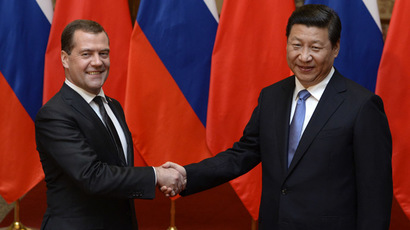China energy deals ‘launch pad’ for Russia’s gas diversification - Moody’s

Moscow’s 15-month marathon of energy deals with China will boost the credit of Russian oil and gas companies and reduce Russia’s reliance on European energy markets, Moody’s Ratings Agency said in a note.
Russia’s oil majors- Rosneft, Gazprom, and Novatek have all struck major deals with Chinese partners, which provide long-term financial stability for the companies, which are at risk of Western sanctions and decreased demand in Europe, Moody’s said Tuesday.
"Russia's efforts to diversify its energy exports, are aligned with China's desire to secure new oil and gas supplies to meet its large and fast-growing energy needs," Julia Pribytkova, Vice President and Senior Analyst at Moody’s, wrote in the report entitled "Russian Energy Deals with China Provide new Growth & Funding Prospects Amid Sanctions."
Both Rosneft and Novatek have been targeted by the US and EU in sectoral sanctions aimed at hitting Russia’s energy sector. Gazprom has not fallen under sanctions.
On Tuesday, Gazprom broke ground on the Power of Siberia pipeline, which when complete in 2018, will be the world’s largest fuel network. The 3,968 km pipeline linking gas fields in eastern Siberia to China will deliver 38 billion cubic meters of gas annually for 30 years.
"Gazprom's deal, which is valued at $400 billion, will also provide a launch pad for the company's full-scale diversification into the Asia-Pacific region at a time when it is facing sales pressure in Europe," Pribytkova said.

If the second planned pipeline, the Altai, is completed, China will become Russia’s biggest gas customer.
In 2013, Rosneft, Russia’s largest state-oil company signed a $270 billion deal to supply China National Petroleum Group with roughly 360 million metric tons of crude over 25 years. By 2020, Rosneft plans to send 46 million tons of crude oil and 16 billion cubic meters of gas to China.
Novatek also signed a deal with CNPC to deliver 3 million tons of liquefied natural gas (LNG) over the next 20 years from its $27 billion Yamal liquefied natural gas project in the north of Russia.
Russia’s geographical position suits it to simultaneously serve the Western and Eastern markets, providing oil both to Europe and China from its largely untapped Siberian reserves, which are among the world’s largest.
Even though China’s growth is slightly slowing, overall it is anticipated to continue outperforming Europe, where demand has slumped since the 2009 euro crisis.
A big challenge Russia will face in China is pricing as there is more price pressure from Beijing as there is from Brussels. It is estimated China will pay $390 per 1,000 cubic meters, less than the average $400 European customers pay. However, the advantage in China for Russian companies is the assurance brought by long-term contracts of up to 30 years.
Worldwide, Russia accounts for 5 percent of LNG supply and 30 percent of pipeline deliveries.
On Tuesday, Rosneft offered China a shareholding in its second-largest oil field, Vankor in the Krasnoyarsk region in Eastern Siberia. The area is estimated to have reserves of 520 million metric tons of oil and 95 billion cubic meters of natural gas.














